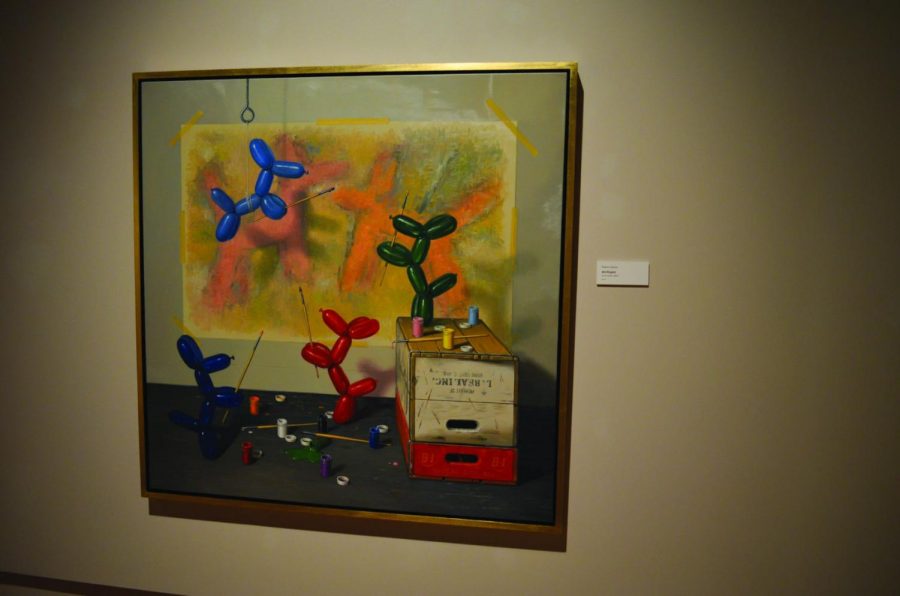Three new exhibits on display at art museum
Robert Jackson’s “Art Project,” painted with oil on linen in 2014. Part of Jackson’s “Without a Net” exhibit in the South Dakota Art Museum. Valued at $22,000.
September 10, 2014
Paintings containing bright – colored balloon dogs, unrealistic stacks of pancakes and edible looking fruit appear in Robert Jackson’s exhibit at the South Dakota Art museum.
Jackson, along with Gerald Cournoyer have exhibits featured in the art museum.
Both Jackson and Cournoyer’s exhibits opened on June 10 and will be on display through Sept. 21. There will be a free reception on Sept. 19 from 4:30 p.m. to 7:00 p.m.
“We really try to show local, state, regional, national, international and get a really good mix of different works at the museum,” said Jodi Lundgren, the curator of exhibitions at the Art Museum. Lundgren has been the curator of the museum for one year.
Both exhibits have a different style of art.
“The exhibits are generally scheduled two years in advance,” said Stacy Buehner, the marketing and development Coordinator of the South Dakota Art Museum.
According to Lundgren, Exhibits need to be scheduled two or three years in advance so artists can create works and so the museum can organize shipping.
“The curator before me goes out to New York and he found Robert Jackson at a gallery he visited when he was out there,” Lundgren said.
Jackson is a contemporary still–life painter from Pennsylvania. His paintings have been influenced by pop – art.
“He’s really honed in on his specific style and the use of these colorful crates and these anthropomorphic sized balloon dogs and fruit,” Lundgren said.
The main subjects in his paintings are balloon dogs and animated situations.
According to Lundgren, Jackson’s paintings bring a sense of fun to the museum.
“People just love to see these apples and balloon dogs playing in these ridiculous stacks of pancakes and burgers that could never physically fit into reality,” Lundgren said.
While Jackson’s paintings are fun, they also deal with deeper issues in a subtle manner.
“I think the ideal purpose is that anybody can come in here [the art museum] and they can find something that they like or something that they can connect with,” Buehner said.
“I come every few weeks,” said Chris Francis, a Madison, SD community member. His favorite part of the museum is the collections.
Marketing is a key aspect of the museum because people need to know when exhibits are leaving and when new exhibits are arriving.
“We do a postcard for the exhibit that gets sent out to all of our members; we usually do a press release for the media so they can get news stories for the local publications so they know what’s going on,” Buehner said.
Social media and fall and spring mailers are other ways that the museum advertises.
“The museum has always had a strong commitment to South Dakota artists, to art in the region, and supporting art in the middle of the continent,” Lundgren said.
Cournoyer is a Lakota painter. He has three different styles of paintings present in his exhibit at the art museum that all tie to his Lakota heritage.
“The glass works, the more traditional paints and then these pieces that have this chuck – close break up of space patterning on them with the concentric circles,” Lundgren said.
His glass works are paintings that are painted reverse on glass.
“The things you see on top were painted first. The background was painted last. He would go under the glass to look at the progress of it,” said Lundgren.
After painting on the glass, he puts canvas on the paint and slowly peels the canvas away to adhere the painting to the canvas.
“The use of color and patterns, the symbols, animals like the ravens, butterflies, dragonflies all have cultural significance for him … The patterning in his work and the rhythm that’s created with that type of patterning to significance of dance, music and prayer and the use of repetition of that Lakota culture to bring closer the scared or supernatural beings,” Lundgren said.
The museum is a place to experience art and offers a quiet environment for students.
“We like to think of the museum as a place where students can come in here and relax. To just wander around and find some peace and enjoyment when they come in here,” Buehner said.
























